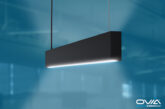
Have you and your customers considered turning to solar to power electric vehicles? Here we discover some of the compelling reasons to adopt dual energy sources.
Homeowners who are environmentally conscious and seeking energy independence now have more options than ever to use renewable energy at home.
Solar panels are the most frequently used way to get renewable energy into the home, and we’re now seeing renewable energy used for more than just powering appliances and switching on lights.
When looking to start maximising the potential of renewable energy sources with dual energy sources, electric vehicle charging is a great place to start and offers a solution that is perfect for optimal energy efficiency.
Electrical vehicle specialist evec, recently launched its EV home chargers (VEC01 & VEC03) with the addition of standard solar integration. These upgraded chargers can harness the sun’s power, making charging EVs easier than ever and more cost-effective if you have access to solar panels.
Switching to EVs already reduces the lifetime emissions of a car by three times, but why should electrical installers advocate for solar-powered EV charging and dual fuel use in the home?
Eco-friendly advantage
By tapping into solar energy, EV owners further reduce their carbon footprint. The environmental impact is significantly reduced when combined with EVs’ inherently lower emissions.
Cost savings
Implementing multiple energy systems can help homeowners reduce their reliance on fossil fuels and high electricity bills. Selling excess energy back to the grid can also generate income.
Flexible charging
Solar-powered charging allows EV owners to adapt charging to schedule and tariff preferences.
With solar integration, you can charge either with sunlight during the day or through the use of a cheaper tariff overnight (or both). The evec App, for example, also has a specific “eco (solar only) mode,” which allows users to charge using solar power only.
Various grants are also available across the UK, and a 0% VAT option can offset the cost of the initial installation of solar panels, making their integration even more appealing for home and EV owners. So, let’s now look at some of the technicalities and considerations involved:
Solar panel functionality
Photovoltaic (PV) cells absorb sunlight, converting DC energy to AC through a solar inverter. This AC power can then be used to support all electric devices.
Integration requirements
While any EV charger can connect to solar panels, a PV inverter is essential for converting DC to AC. Some EV chargers, like the evec VEC01 & VEC03, already have this integrated technology.
Number of panels
The right number of solar panels depends on factors like EV range and energy requirements. According to Octopus Energy, an average solar panel system of 8-12 panels can charge an EV. This would give an average of 1 to 4 kWp – enough to charge an average EV in about eight hours.
Electrical installers advocating for solar-powered EV charging align with sustainable practices and help meet the evolving needs of eco-conscious clients.
To get the greatest benefits, home and EV owners should integrate multiple renewable energy systems to provide sustainable and reliable home energy solutions.
Get more details about evec’s range of EV chargers with solar integration here
Read more industry features here









